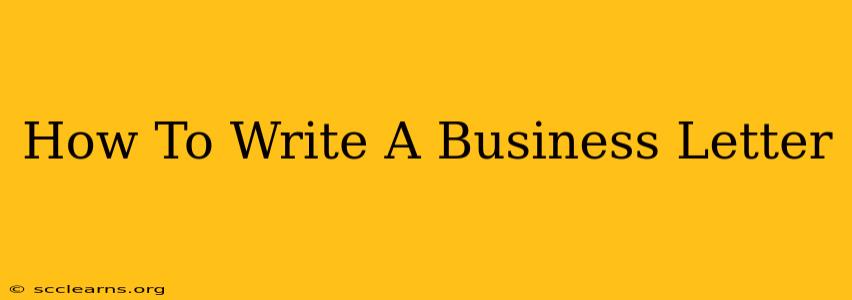Writing a professional business letter might seem daunting, but with a clear understanding of the format and key elements, it becomes a straightforward process. This guide provides a step-by-step approach to crafting effective business letters that convey your message clearly and professionally. Mastering this skill is crucial for various business communications, from inquiries and proposals to complaints and formal requests.
Understanding the Purpose of Your Business Letter
Before you even begin writing, define the purpose of your letter. What are you trying to achieve? Are you requesting information, making a complaint, proposing a collaboration, or something else entirely? Knowing your objective will dictate the tone and content of your letter.
Key Considerations Before You Begin:
- Identify your audience: Who are you writing to? Understanding their position and relationship to you will influence your writing style.
- Determine your objective: What specific outcome are you aiming for?
- Gather necessary information: Collect all relevant details, dates, and supporting documentation before you start writing.
Essential Elements of a Business Letter
A well-structured business letter adheres to a specific format, ensuring clarity and professionalism. Let's break down the key components:
1. Your Contact Information:
- Your Name: [Your Full Name]
- Your Address: [Your Street Address, City, State, Zip Code]
- Your Phone Number: [Your Phone Number]
- Your Email Address: [Your Email Address]
- Date: [Date]
2. Recipient's Contact Information:
- Recipient's Name: [Recipient's Full Name, Title]
- Company Name: [Company Name]
- Company Address: [Company Street Address, City, State, Zip Code]
3. Salutation:
- Use a formal salutation, such as "Dear Mr./Ms./Mx. [Last Name]," If you are unsure of the recipient's gender, using "Dear [Last Name]," is acceptable. If you're writing to a company, use "Dear [Department Name]," or "To Whom It May Concern."
4. Body Paragraphs:
- Keep it concise and to the point: Avoid unnecessary jargon or overly complex sentences. Use short paragraphs to improve readability.
- Clearly state your purpose: Begin by stating the reason for writing in the first paragraph.
- Provide supporting details: In subsequent paragraphs, provide relevant information, evidence, or examples to support your claims or requests.
- Maintain a professional tone: Use polite and respectful language throughout the letter.
5. Closing:
- Use a professional closing, such as "Sincerely," "Respectfully," or "Regards."
6. Signature:
- Handwrite your signature above your typed name.
7. Enclosures (Optional):
- If you're including any additional documents, mention it with "Enclosures:" followed by a list.
Tips for Writing an Effective Business Letter:
- Proofread carefully: Errors in grammar and spelling can damage your credibility.
- Use a professional font: Stick to classic fonts like Times New Roman or Arial.
- Maintain consistent formatting: Use consistent spacing and margins throughout the letter.
- Keep it concise: Get straight to the point and avoid unnecessary details.
- Use strong verbs: Make your writing more active and engaging.
Different Types of Business Letters:
The structure remains largely consistent, but the content will vary depending on the purpose. Common types include:
- Cover Letters: Accompany resumes when applying for jobs.
- Complaint Letters: Formally address a problem or issue with a product or service.
- Inquiry Letters: Request information or clarification.
- Order Letters: Place an order for goods or services.
- Sales Letters: Promote a product or service.
- Recommendation Letters: Recommend someone for a job or opportunity.
By following these guidelines, you can confidently craft professional and effective business letters that achieve your desired results. Remember, clarity, conciseness, and professionalism are key to a successful business letter.

